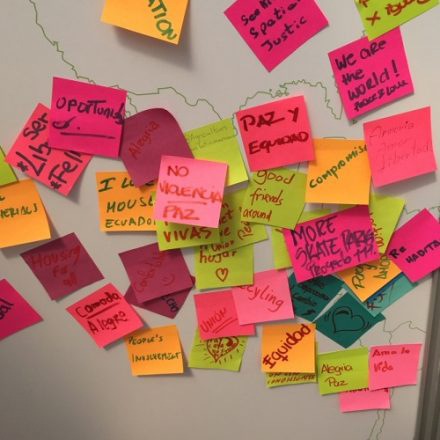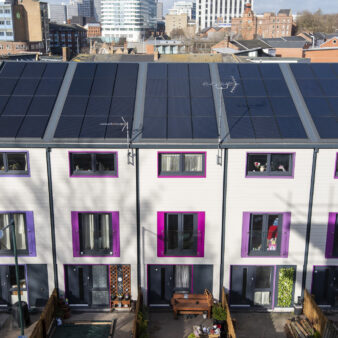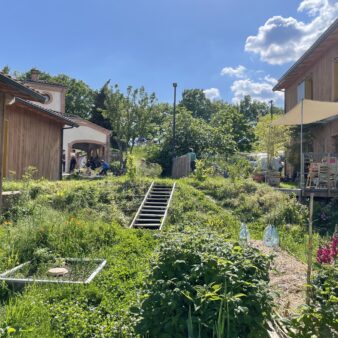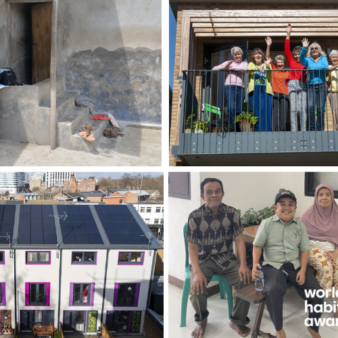
World Habitat visited Habitat III, the UN Conference on Housing and Sustainable Urban Development in Ecuador in October 2016. As with any UN event much of the conference was filled with important discussions and plans for a more sustainable future.
On our exhibition stand about the World Habitat Awards we wanted to create engagement and discussions with the thousands of people attending the conference. So we decided to go back to basics and we spoke to the public, housing professionals, government officials and lots of people from around the world. We asked them what qualities make a ‘home’.
It is perhaps easy to define a ‘house’ as a physical space where we live and carry out our everyday lives. Although houses come in many different shapes, the physicality of them is something many people see in the same way.
However, the idea of ‘home’ is much more subjective, which people relate differently to.
The ideas shared by people at Habitat III got me thinking about our World Habitat Awards winners and finalists. These outstanding projects not only provide housing solutions but also ensure that home is a space of safety, happiness and security.
What really stands out to me is that many of our award winners and finalists have worked to create ‘homes’ even when faced with housing difficulties and problems.
Here are five of my favourite answers to “what makes a home?” from our discussions at Habitat III, and how they relate to the work of some great World Habitat Awards winners and finalists.
1. People’s involvement

Most of our World Habitat Awards winners and finalists are people focused with many also being self-build and community-led.
One project that particularly stands out for their strong involvement of people and communities is our 2014 finalist ‘Indigenous People Building their Homes’, Mexico.
This project takes a rights based approach to help low-income families living in three rural municipalities. Communities are supported to build homes using local construction methods and innovative social financing methods have made homes much more affordable to local people in comparison to other local homes.
2. Paz y equidad (Peace and Equity)

For many people around the world conflict is an unacceptable part of their everyday life. A home away from conflict can change lives, allowing people to fulfil their right to peace and equity.
‘Nashira, a song of love, a women-led project’, Colombia is a 2015 World Habitat Awards finalist. The project works to provide a home for women to give them peace from both displacement as a result of the country’s civil war and domestic violence. The village provides 88 homes that are both permanent and affordable, giving women a base to start the next positive chapter of their lives.
3. Re-habilitar (Rehabilitation)

A number of our winners and finalists support those who have suffered from various addictions to rehabilitate and continue their lives in a more positive way.
2012 finalist ‘Odyssey House Family Units’ in Australia helps parents, including single fathers, in the rehabilitation process after alcohol and drug addiction and enables them to continue living with their children in a therapeutic community.
4. The use of local materials
 For homes to be sustainable in the long run their development should utilise local people’s skills and local materials. Our 2016-17 winner ‘A Roof, A Skill, A Market’ achieves this through the use of locally available sundried mud bricks. Building homes this way reduces their carbon footprint and reduces the local demand for timber which lowers the amount of tree felling.
For homes to be sustainable in the long run their development should utilise local people’s skills and local materials. Our 2016-17 winner ‘A Roof, A Skill, A Market’ achieves this through the use of locally available sundried mud bricks. Building homes this way reduces their carbon footprint and reduces the local demand for timber which lowers the amount of tree felling.
5. Acceptance and welcome
 Home should be a space where you can be yourself, feel free to do as you please, and an area where you feel accepted. Yet, for many the home can be a space where further oppression prevails.
Home should be a space where you can be yourself, feel free to do as you please, and an area where you feel accepted. Yet, for many the home can be a space where further oppression prevails.
Social inclusion and improvement of living conditions for Roma, Serbia is a 2014 World Habitat Awards finalist. This project works to ensure the Roma Community is recognised by state and municipal institutions to receive home improvements. In circumstances where discrimination against the Roma community is rooted in everyday life this is an important step towards providing safe, secure homes for Roma populations.
There’s hundreds of inspiring housing projects around the world, changing lives and providing homes for people. Find out more here.
Housing is a RIGHT, not a commodity
The idea of ‘home’ is something that Leilani Farha, the UN Special Rapporteur on the right to housing, is particularly interested in.
On her website she explains:
“Housing is the cornerstone to life and human well-being. Home is so much more than four walls and a roof. It is somewhere to live in peace security and dignity. Although it is increasingly being treated as a commodity, housing is a fundamental human right. The right to housing does not mean that everyone is entitled to a government provided home immediately. It means governments must ensure that everyone – particularly the most disadvantaged groups – should have access to housing that is adequate. Housing is only adequate if it is affordable, if it has potable water, sanitation facilities, electricity and other basic services and if it is close to schools, health services and employment opportunities…”
Leilani is currently reaching out for people to share their testimonies about what a home means and the right to housing and you can share your story here.




Join the discussion